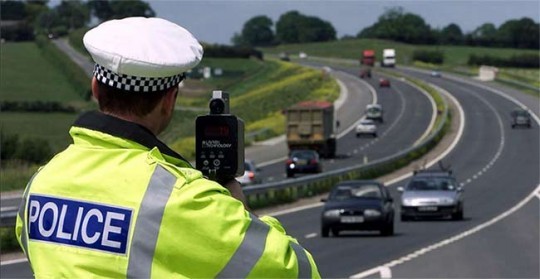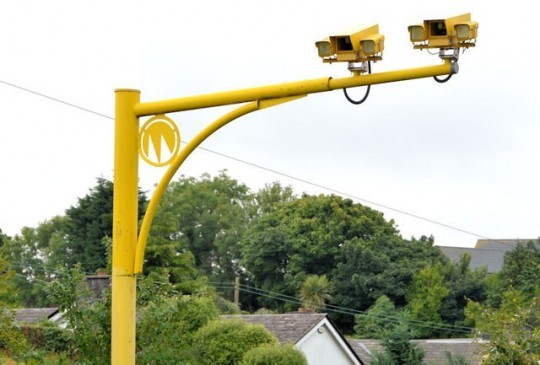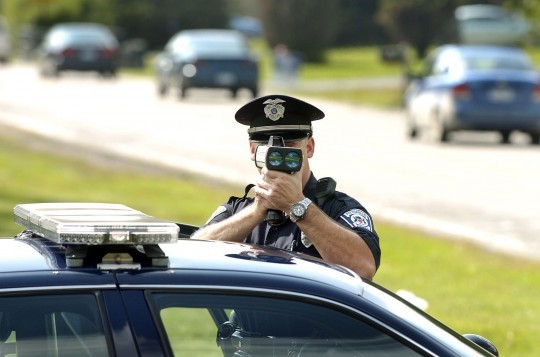
The speed camera, or the traffic enforcement camera, as it is known among police officers and administrative offices, dates back as far as 1905. That year, a patent for a so called Time Recording Camera for Trapping Motorists (notice the trapping term…) was filed.
The working principle behind this primitive equipment was basically the same as the one used in modern day one, only that it used a more direct approach. The camera would take two photos of a car as it moved across the start and end points of a measured section of the road. It’s not clear what exactly triggered the system.
Several other attempts to develop an usable sideline camera were made during the following 60 years or so, with the most notable one being that manufactured by Dutch company Gatsometer BV, founded by rally driver Maurice Gatsonides. He was trying to use the photographic equipment to help him improve his driving, by monitoring speed around corners. His camera was the first automated road-rule enforcement system. Currently, Gatsometer is the world’s biggest supplier of speed camera systems, and you should also blame it for inventing the first radar used in road traffic.
The first cameras began getting introduced starting with the 1960s. These units used film to record the image and they largely remained in use until the early 1990s, when digital speed cameras came into the spotlight.
Currently, based on how they are used, speed cameras can be divided into three large groups: mobile systems, fixed speed cameras and average speed cameras. Based on the technology they use, they can also be divided into laser, truvelo and SPECS.
MOBILE CAMERAS
 The mobile cameras are the ones to be found on police vehicles. Also referred to as radars, they come in a variety of shapes and sizes, being vehicle-mounted, hand-held, tripod mounted and concealed (meaning hidden where you least expect).
The mobile cameras are the ones to be found on police vehicles. Also referred to as radars, they come in a variety of shapes and sizes, being vehicle-mounted, hand-held, tripod mounted and concealed (meaning hidden where you least expect).
This type of camera comes with its built-in detection equipment, allowing the carrier to accurately record the speed of incoming motorists regardless of the carrier being stationary or not. They can also detect speed regardless of the carrier moving with or against the flow of traffic.
The camera is based on laser technology, emitting a light beam towards the incoming vehicle. It takes the beam 0.3 to 0.7 seconds to acquire and register a target at an operational range of 800 meters.
What happens after the target is locked is called the Doppler effect and can be explained as follows.
The radar sends out the beam at specific frequencies and at an angle across the roadway. When a car enters its field, the radar is reflected and the beam changes frequency because of the relative motion between the radar and the vehicle. The degree in which the frequency increases or decreases depends on the speed at which the passing vehicle is traveling.
Mobile cameras are also capable of detecting the direction in which the monitored vehicle is traveling in. Frequency is the main tool here as well: if it increases, the vehicle is incoming, while if it decreases, the vehicle is moving away from the carrier.
And now, a little on how the radar determines the size of the ticket you will get: how does it determine speed? As we said above, the degree in which the frequency increases or decreases is used to determine speed. Because the beams are directed at an angle (usually 20 degrees) compared to the road, the shift in frequency will indicate a speed lower than the target’s actual speed. The radar calculates the slant angle and then, using trigonometry, it determines the speed in the direction of travel. FIXED SPEED CAMERAS
 That strange, brightly colored box or cannon sitting on the side of the road is what is called a fixed camera. It can also be seen mounted on stoplight poles in major cities, or can be seen hanging on overpasses or bridges which intersect the road.
That strange, brightly colored box or cannon sitting on the side of the road is what is called a fixed camera. It can also be seen mounted on stoplight poles in major cities, or can be seen hanging on overpasses or bridges which intersect the road.
This type of camera detects the speed of vehicles by using piezo electronic detectors (tiny wires) embedded into the road surface (usually, there are two sets of wires embedded into the road). When a car passes over one of the detectors, an electronic signal activates the camera. If the speed of the vehicle is higher than the limit, a digital picture of the vehicle is taken. The speed is determined depending on the amount of time it takes the car to reach the second wire.
Fixed speed cameras record date, time, location, direction of travel, speed, the speed limit on that portion of the road (for comparison) and the lane in which the car was traveling.
The fixed camera can differentiate between lanes and can pick up the offending car from a line of vehicles. Being mounted at an angle (either horizontal or vertical), hiding behind the car in front won’t do, as the camera will still be able to read the license plate. In multi-lane conditions, each of the lanes gets its own piezo detectors and telephoto lens camera, while all lanes are watched over by a wide angle lens.
AVERAGE SPEED CAMERAS

Perhaps the most simple of them is the average speed camera, also known as automatic number plate recognition (ANPR) camera. It does not use lasers, beams, GPS or any other modern invention, but the good old photo camera and a little bit of math.
The principle behind the average speed camera is simple: knowing the distance between point A and point B, as well as the time a vehicle departs point A, it’s easy to determine the average speed of that car between the two points. Using infrared and a vehicle database, the system identifies the car by reading the license plate.
Officially, this type of camera is called Speed Enforcement Camera System (SPECS), but is also known in some countries (like the UK) as Speed Violation Detection Deterrent (SSVD). FREQUENCY
For laser-based speed cameras, there is a set of internationally agreed upon frequencies on which they operate. Starting with the 1960, the so called X band (10.525 Ghz +/- 50 Mhz and 24.150 Ghz+/- 100 Mhz) was used for trapping motorists. It currently lost much of this role, as it is used to power automatic doors. That’s why radar detectors are able to pick up the signal, sending false readings.
In the 1970s, the lower frequency K band was introduced (24.150 Ghz+/-100Mhz and 24.050-24.250 Ghz), while in Europe the Ka band (33.4GHz-36GHz. +/- 100Mhz) started being used in the 1980s. The last addition to the frequency range is the Ku band (0.70 – 12.75 GHz. +/ – 100Mhz).
WHICH IS THE BEST OR WORST
It’s hard to say which of the three large systems is the best (if you are the police) or worst (if you are the offender). Generally, all three work, otherwise we wouldn’t have all the debate on the matter, now would we? If we are to look objectively however, we must say the last system described here, the SPECS, is the best.
First of all, it uses far less high-tech to work, making it less susceptible to counter-measures (radar detectors, jammers, and so on). Secondly, it is less susceptible to controversy, as it averages the speed of a car for a long distance, instead of measuring it at one fixed point. This means slowing down when you approach a SPECS camera and speeding again until you get to the next won’t shelter you from harm and is sure to get you a ticket.
After all, if the distance between point A and point B is X, and the time to get from A to B abiding by the law is Y, then how come you managed to do it in time Z, where Z is way smaller than Y?








